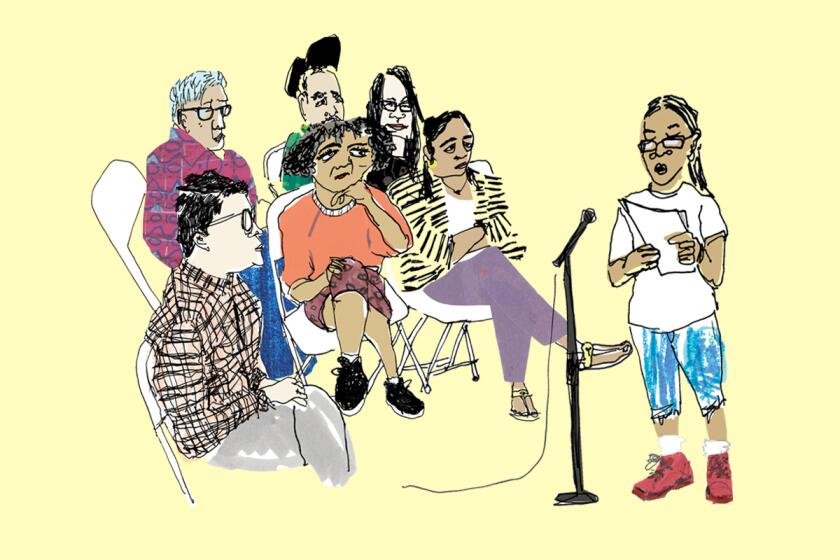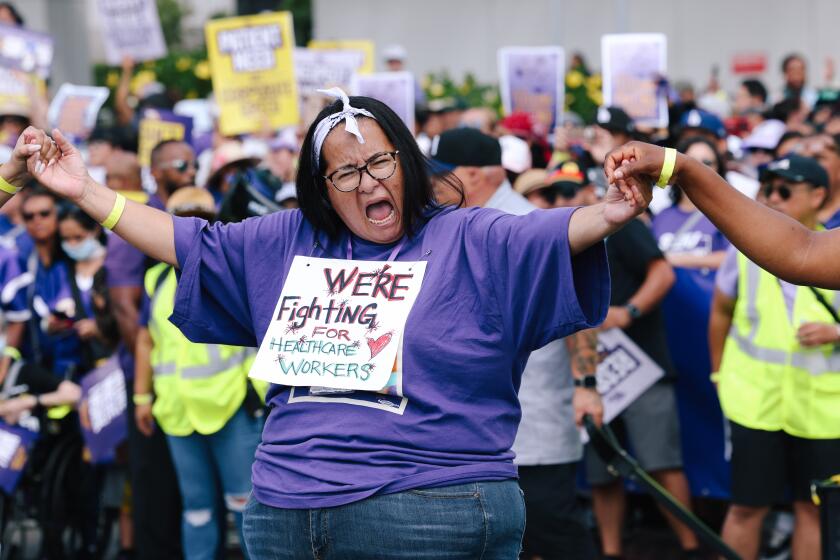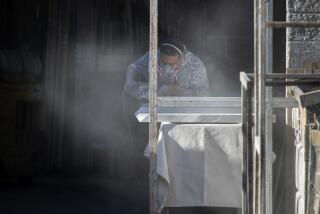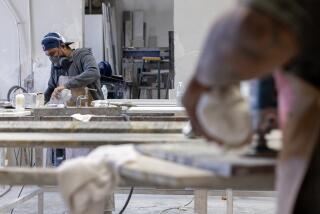California workers who cut countertops are dying of an incurable disease
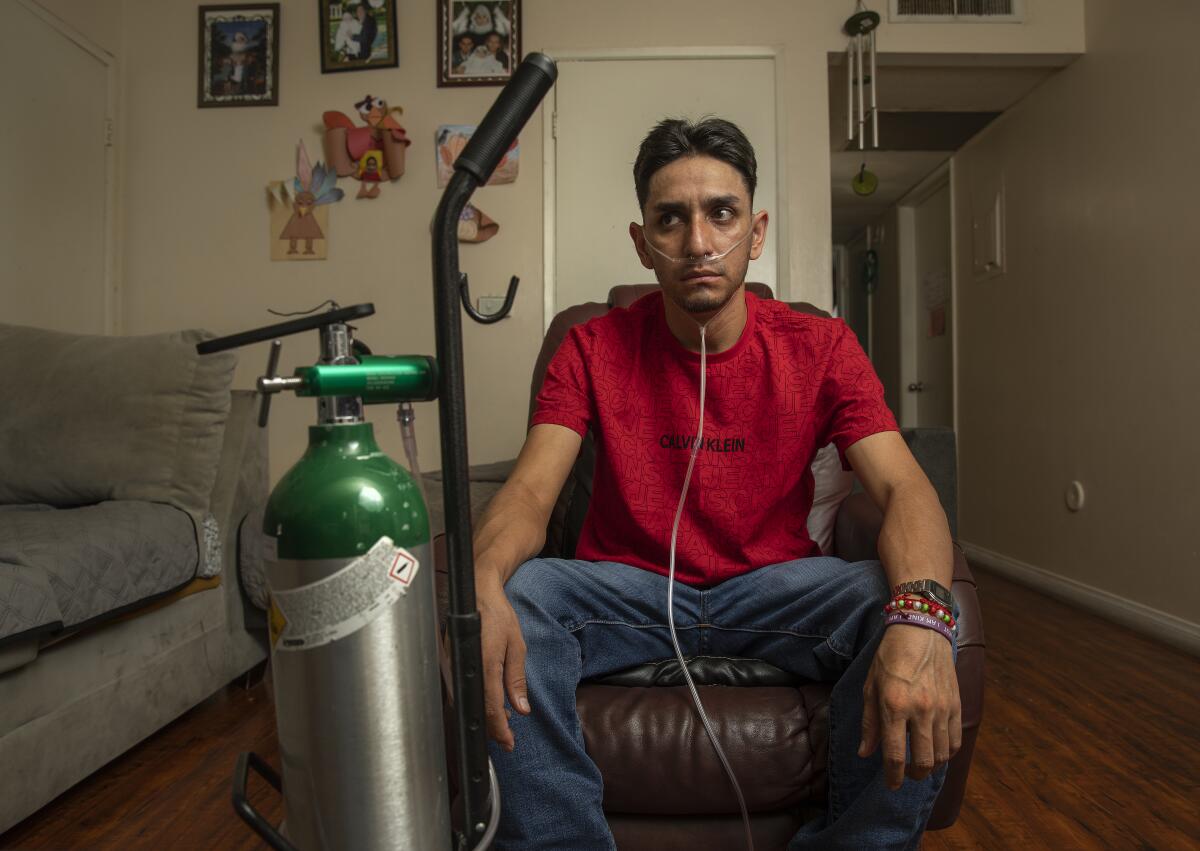
- Share via
Inside the row of workshops in an industrial stretch of Pacoima, men labored over hefty slabs of speckled stone, saws whining over the sounds of Spanish-language rock.
Pale dust rose around them as they worked. Many went without masks. Some had water spurting from their machines, but others had nothing to tamp down the powder rising in the air.
“Nobody uses water,” one man in a Dodgers cap said in Spanish when Maria Cabrera approached, holding flyers about silicosis, an incurable and suffocating disease that has devastated dozens of workers across the state and killed men who have barely reached middle age.
Cabrera, a community outreach worker with the nonprofit Pacoima Beautiful, urged him and others at the Branford Street site to try to protect themselves. Silicosis can ravage the lungs of workers after they inhale tiny particles of crystalline silica while they cut and grind stone that contains the mineral.
The disease dates back centuries, but researchers say the booming popularity of countertops made of engineered stone, which has much higher concentrations of silica than many kinds of natural stone, has driven a new epidemic of an accelerated form of the suffocating illness. As the dangerous dust builds up and scars the lungs, the disease can leave workers short of breath, weakened and ultimately suffering from lung failure.
“You can get a transplant,” Cabrera told the man in Spanish, “but it won’t last.”
In California, it has begun to debilitate young workers, largely Latino immigrants who cut and polish slabs of engineered stone. Instead of cropping up in people in their 60s or 70s after decades of exposure, it is now afflicting men in their 20s, 30s or 40s, said Dr. Jane Fazio, a pulmonary critical care physician who became alarmed by cases she saw at Olive View-UCLA Medical Center. Some California patients have died in their 30s.
“They’re young guys who essentially have a terminal diagnosis,” Fazio said.
Do you know who your L.A. County supervisor is? Do you know how to get her attention? Use Shape Your L.A. to get active in your community.
In Pacoima, a 27-year-old father said he now has to hustle home from the park with his 8-year-old daughter and 5-year-old son because his oxygen tank starts to run out as they play. Leobardo Segura Meza said he could no longer run around on the soccer field or exercise the way he used to.
Nor is he able to work. For a decade, he made a living by cutting, polishing and installing countertops in and around Los Angeles County. Dust was everywhere, he said, and he was given only a dust mask — one he said was inadequate for the job — to protect himself. Sometimes he brought a hose and tried to attach it to the machine to reduce dust, but there were no machines dispensing water as they were cutting, he said.
He began to suffer a cough that wouldn’t go away and lost his breath when going up stairs, he said. His weight dropped. At one point, he was hospitalized when one of his lungs collapsed.
Segura Meza had never heard of silicosis before he was diagnosed. “There’s no cure for this illness. The only thing they can do is a lung transplant,” he said in Spanish.
What he fears, he said, is that as more workers grow ill, “there aren’t enough lungs for us.” At a state hearing this summer, Segura Meza said two of his co-workers had already died waiting for transplants.
To warn workers about the threat, Cabrera and another Pacoima Beautiful outreach worker, Claudia Vasquez, made their rounds at the parking lot of the Home Depot in San Fernando, where laborers in long-sleeve shirts waited for people to drive up and offer them work. Few had heard of the disease.
“It’s very dangerous, this illness?” asked one man in Spanish, leaning against a palm tree in the parking lot.
Cabrera told him there was no cure. She urged him to use wet saws to limit any dangerous dust rising in the air and NIOSH-approved respirators to avoid breathing it in. Workplace safety regulators have recommended a suite of measures including water spraying systems, ventilation and vacuum systems to clear dust, in addition to protective respirators for workers — ones covering the entire face if silica levels in the air are high.

The risk is serious for workers in the industry: Although estimates of its prevalence vary from study to study, some screenings in Australia have found roughly 1 in 5 stone workers had the disease. In California, workplace safety regulators have estimated that out of roughly 4,000 workers in the industry across the state, silicosis will afflict between 485 and 848 — and that as many as 161 could ultimately die.
A recent study by UCLA and UCSF physicians found that among dozens of California workers who got silicosis from grinding countertops, nearly a fifth had died. Their median age at death was 46. More than half had suffered delays in getting diagnosed, as the disease was mistaken for bacterial pneumonia or tuberculosis, and over a third already had severe scarring in their lungs when they were diagnosed.
Los Angeles County has been an epicenter of the debilitating disease, with 60 out of the 83 cases among countertop workers identified across the state since 2019 by the California Department of Public Health.
The San Fernando Valley is a hub for the stone “fabrication” industry — those who cut and polish the slabs made by manufacturers — and county officials also said that growing awareness spurred by Fazio and others may have resulted in better reporting of such cases in L.A. In July, the state sent out an advisory to healthcare providers about the threat, recommending that physicians ask if ailing patients have worked as countertop cutters and urging them to report any identified cases of silicosis to the state.
California workplace safety regulators are now drafting emergency rules to try to protect workers as engineered stone has come to dominate the countertop industry. The material is also sometimes called artificial or synthetic stone, made with crushed quartz bound together with resin. L.A. County is exploring whether to go further and ban the sale and installation of “silica engineered stone” entirely.
Existing safety standards must be followed, but “we feel that there need to be additional changes to the standards to make it even more safe in the workplace,” said Dr. Nichole Quick, deputy director of health protection with the L.A. County public health department.
The county department is now preparing a report requested by county supervisors on options for a potential ban, as well as other possible steps. It has also partnered with Pacoima Beautiful to provide outreach. “This is a preventable disease,” Quick said, “and we want to take appropriate action to make these workplaces safer.”
One question before the county — and government regulators across the globe — is whether any safeguards will effectively protect workers grinding materials so high in silica. The Agglomerated Stone Manufacturers Assn., an international group representing manufacturers of engineered stone, maintains its products can be cut “with no safety issues or health hazards if it is performed according to the best practices.”
In a statement, the association said the risk lies not with engineered stone itself, but poor adherence to safety measures by fabricators, arguing that safety regulations need to be “simplified and rigorously enforced.” Members of the Stone Coalition, which represents fabricators as well as manufacturers, said an L.A. County ban would have “severe economic consequences” and argued for additional enforcement and training on workplace safety, especially efforts to eliminate “dry cutting.”
And the Los Angeles County Business Federation contended that enforcing safety regulations “will do more to prevent disease, while not adversely [affecting] the cost of construction at a time when Los Angeles is seeing a devastating housing crisis.”
But Raphael Metzger, a Long Beach attorney who represents Segura Meza and other workers suing manufacturers of engineered stone such as Cambria and Caesarstone for damages, argued that typical respirators and other standard measures don’t go far enough. Even with many “wet methods,” workers can be exposed to dangerous levels of silica and need additional protection, NIOSH research has found.
SEIU United Healthcare Workers West said nearly 60,000 workers in California had approved a possible strike, teeing up what could be the biggest strike by healthcare workers in U.S. history.
Nearly half of the workers suffering silicosis in the UCLA and UCSF study said their workplaces were using water to control dust. Roughly a quarter said they always had respiratory protection. Fazio said studies have found that in many shops, dust is so thick in the air that respirators cannot filter out a sufficient amount.
Metzger argued that the kind of sophisticated and costly measures that would be needed to reliably protect workers cutting engineered stone are not economically plausible in an industry where immigrant workers typically labor in small shops and are often paid in cash. Engineered stone “is too dangerous to be used safely,” he said. “If there’s any industrial product that should be banned, this is the product.”
Segura Meza agreed, calling it “very deadly.” Vasquez, with Pacoima Beautiful, said that when she and Cabrera started talking to workers about engineered stone and silicosis, many of them asked, “How come they don’t do anything with the stores that sell the products?”
In Australia, where the government is weighing whether to ban engineered stone, a professional group whose members assess worker health hazards concluded that the high concentration of silica in engineered stone makes it difficult for measures such as wet cutting and ventilation to adequately protect workers.
Additional measures for respiratory protection are needed, but such systems “have largely been absent from this sector,” the Australian Institute of Occupational Hygienists wrote. In light of those concerns, it recommended prohibiting engineered stone containing more than 10% crystalline silica, but said it would also support banning all engineered stone because of the rigorous compliance needed even at a 10% level.
In California, existing rules to protect workers have often not been followed, state regulators found. Cal/OSHA, which is now hustling to draft emergency standards to protect California workers in the stone cutting and polishing industry, found rampant violations of the current standards when it looked closer in 2019 and 2020.
Despite the rise of the deadly disease, homeowners and other consumers shopping for countertops know little about the threat it could pose to the workers behind the surfaces in their kitchens and bathrooms, Fazio said. Engineered stone is now estimated to represent more than 60% of materials used for countertops, the L.A. County business federation said, and market researchers say its popularity is only expected to rise.
Engineered stone “is everywhere and people have no idea,” Fazio said. Consumers “have a right to know that the countertop that might be the cheapest one ... may really be costing folks’ lives.”
More to Read
Sign up for Essential California
The most important California stories and recommendations in your inbox every morning.
You may occasionally receive promotional content from the Los Angeles Times.
